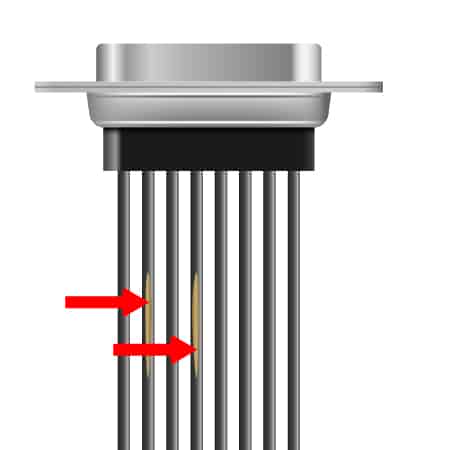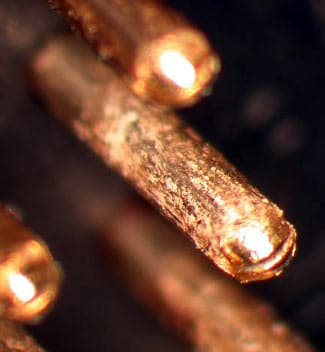Testing for Intermittent Errors in Cable and Harness Assemblies
Just because a cable has tested good does not mean that it is definitely a good cable. This article will discuss one of the most troubling aspects of electrical cable assemblies and wire harnesses: intermittent errors.
Like most electronic components, cables and wire harnesses are subject to manufacturing defects, and like most components, it is standard procedure to test them electrically. Testing easily detects failures that repeat every test or are easy to duplicate. Intermittent failures, however, can be much more difficult to find. It is possible to improve your products by understanding the source of intermittent errors and attacking the root cause to eliminate them.
- Make sure that your harness tester and interface fixturing support the detection of intermittent problems.
- Use testing for feedback and take appropriate action to remove root causes, rather than just attempting to test the quality of your cables.

What is an intermittent error?
There are three basic problems that occur in wire harnesses: opens, shorts, and miswires. When these errors occur sporadically, they are described as intermittent errors. Intermittent errors are usually caused by some mechanical change such as temperature, mechanical vibration, or physical flexing. These factors temporarily change the electrical characteristics of the device-under-test to the point where an error is detected. When the change is reversed, the error goes away.
Causes of Intermittent Errors
Since intermittent problems are just that–intermittent–they are much more difficult to find than solid defects. This is because they do not occur consistently. The cable must be in a certain position, or the environment must be at a certain temperature for the error to manifest. Some intermittent errors can be caused by:
- Bad Specs: Setting a pass/fail threshold for continuity tests that’s too low can cause good assemblies to only pass intermittently. See Setting Practical Resistance Specs for Continuity Testing for additional information.
- Cold Solder Joint: If a contact is moved before the solder has set, the solder can become weak. The weakened contact can cause intermittent errors.
- Improperly Seated Pin: A pin not properly seated into a connector could cause an intermittent open.
- Damaged House/Insulation: Wires damaged from connector housing can cause intermittent shorts.
- Bad Interface: Worn contacts on interface cables or defective wiring make it harder to detect intermittent problems within the cable.
- Dirty Contacts: Contacts with flux residue or other contaminates can cause intermittent errors


Intermittent Shorts
In most cases, intermittent shorts are caused by some compromise of the insulating material intended to keep wires isolated from each other. When insulation is breached, there is now an “air-gap” isolating wires from each other for some portion of the cable. When some force (bending, flexing, vibration, aging, etc.) causes the conductors to be isolated by an air-gap, the wires come into physical contact with each other, and a short-circuit occurs. This short may become a repetitive failure or, depending on the nature of the force, remain an intermittent failure.
Intermittent Opens/High Resistance Connections
An intermittent open, or high-resistance connection, occurs when there is temporarily no electrical connection or weak electrical connection (high resistance) from one end of a wire to the other. This can occur in the contact-to-contact mating at either end, the contact-to-wire bond at either end, or the wire itself.
Contact-to-Contact
1. Micro-fretting: Over time, some metals form surface oxides when they come into contact with each other. This is common for tin/lead contacts and is often recognized as micro-fretting. Tin contacts are especially susceptible to this problem unless they have high mating forces (good wiping action) or the application uses more than 10 volts. Micro-fretting is not a problem for gold plated contacts as long as the plating is intact.
Often micro-fretting does not show up in tests. As soon as connectors are re-mated, it goes away. A common field solution of re-mating connectors can cause this problem to disappear only to reappear later. See Tyco’s technical report “The Tin Commandments: Guidelines for the Use of Tin on Connector Contacts” for more information about problems with micro-fretting.

2. Improper mating forces: Intermittent opens can occur when contacts do not mate with the proper force. This can be caused by:
-
- Wear that weakens the spring forces in female contacts or reduces the size of male contacts.
- Contacts that are not fully mated (crimped pins aren’t fully locked into the connector housing and push back when mated).
- Connector shells/mating hardware that interfere with full engagement of the mating connectors.
- Mechanical damage/deformation of contacts.
- Foreign contamination left on contacts. This can be caused by flux left from soldering, cleaning residues, dirt, etc.
Contact-to-Wire
- In crimped connections, intermittent opens (or high resistance connections) are often caused by poor crimps due to improper mechanical adjustment or misuse of crimping tools. Consider crimp pull testing or crimp force monitoring.
- Cold solder joints and poor hand soldering can cause intermittent problems.
- IDC connectors can have intermittent problems due to bent tines, cut strands, misalignment of planar cable, including variation in spacing of wires in ribbon cable and improper use of application tools.
The Wire Itself
Apart from problems caused at the point of wire-to-contact termination as discussed above, intermittent problems in the wire itself usually occur after the assembly has been put to use. This can be caused by flexing, stretching, or bending a cable more than expected. These types of problems are usually not solved by improving testing, but rather by design changes such as using more strands of wire in the conductors, limiting the flexing and stress experienced by the assembly with improved strain reliefs, etc., and by protecting the assembly with better jacketing.

